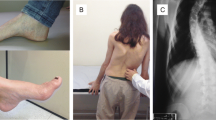Abstract
Friedreich’s ataxia (FRDA) affects very young persons. In a large series, the mean ages of onset and death were 11 and 38 years, respectively. The clinical spectrum of FRDA has expanded after genetic confirmation of the mutation became a routine laboratory test. The main cause of death in juvenile-onset FRDA is cardiomyopathy whereas patients with late-onset are more likely to succumb to neurological disability or an intercurrent illness. Many patients with early onset now survive for 20 years or longer. This study made a systematic comparison of the neuropathology in 14 patients with juvenile onset and long survival, and five patients with late onset and long survival. Mean ages of onset (± standard deviation) were 10 ± 5 and 28 ± 13 years, respectively. Disease durations were 33 ± 11 and 47 ± 11 years, respectively. Cross-sectional areas of the thoracic spinal cord were greatly reduced from the normal state but did not differ between the two groups. Similarly, the neurons of dorsal root ganglia were significantly reduced in size in both juvenile- and late-onset cases of FRDA. The dentate nucleus showed severe loss of neurons as well as modification and destruction of corticonuclear terminals in all FRDA patients. Delayed atrophy of the dentate nucleus is the likely cause of the ataxic phenotype of FRDA in late-onset cases, but the reason for the delay is unknown. Frataxin levels in the dentate nucleus of two patients with late onset were similar to those of seven patients with juvenile onset.






Similar content being viewed by others
References
Harding AE. Friedreich’s ataxia: A clinical and genetic study of 90 families with an analysis of early diagnostic criteria and intrafamilial clustering of clinical features. Brain. 1981;104:589–620.
De Michele G, Filla A, Perretti A, Santoro L, Trombeta L, Santorelli F, et al. Late onset recessive ataxia with Friedreich’s disease phenotype. J Neurol Neurosurg Psychiatry. 1989;52:1398–401.
Campuzano V, Montermini L, Moltò MD, Pianese L, Cossée M, Cavalcanti F, et al. Friedreich’s ataxia: autosomal recessive disease caused by an intronic GAA triplet repeat expansion. Science. 1996;271:1423–7.
Dürr A, Cossée M, Agid Y, Campuzano V, Mignard C, Penet C, et al. Clinical and genetic abnormalities in patients with Friedreich’s ataxia. New Engl J Med. 1996;335:1169–75.
Koeppen AH. Neuropathology of the inherited ataxias. In: Manto M-U, Pandolfo M, editors. The cerebellum and its disorders. Cambridge: Cambridge University Press; 2002. p. 387–405.
Michael S, Petrocine SV, Qian J, Lamarche JB, Knutson MD, Garrick MD, et al. Iron and iron-responsive proteins in the cardiomyopathy of Friedreich’s ataxia. Cerebellum. 2007;5:257–67.
Koeppen AH, Michael SC, Knutson MD, Haile DJ, Qian J, Levi S, et al. The dentate nucleus in Friedreich’s ataxia: the role of iron-responsive proteins. Acta Neuropathol. 2007;114:163–73.
Koeppen AH, Morral JA, Davis AN, Qian J, Petrocine SV, Knutson MD, et al. The dorsal root ganglion in Friedreich’s ataxia. Acta Neuropathol. 2009;118:763–76.
Friedreich N. Ueber Ataxie mit besonderer Berücksichtigung der hereditären Formen. Nachtrag. Virchows Arch Pathol Anat Physiol Klin Med. 1877;70:140–52.
Ohta M, Offord K, Dyck PJ. Morphometric evaluation of first sacral ganglia of man. J Neurol Sci. 1974;22:73–82.
Condò I, Ventura N, Malisan F, Tomassini B, Testi R. A pool of extramitochondrial frataxin that promotes cell survival. J Biol Chem. 2006;281:16750–6.
Isnard R, Kalotka H, Dürr A, Cossée M, Schmitt M, Pousset F, et al. Correlation between left ventricular hypertrophy and GAA trinucleotide repeat length in Friedreich’s ataxia. Circulation. 1997;95:2247–9.
Wells RD. DNA triplexes and Friedreich ataxia. FASEB J. 2008;22:1625–34.
Inoue K, Hirano A, Hasson J. Friedreich’s ataxia selectively involves the large neurons of the dorsal root ganglia. Trans Am Neurol Assoc. 1979;104:75–6.
Scharf J-H, Blumenthal H-J. Neuere Aspekte zur altersabhängigen Involution des sensiblen peripheren Nervensystems. Zeitschrift Zellforsch. 1967;78:280–302.
Gardner E. Decrease in human neurons with age. Anat Rec. 1940;77:529–36.
Vassilopoulos D, Spengos M, Scarpalezos S. Étude radiologique de la colonne vertébrale cervicale dans certaines maladies dégéneratives neurologiques. J Radiol Electrol. 1977;58:183–6.
Wessel K, Schroth G, Diener HC, Müller-Forell W, Dichgans J. Significance of MRI-confirmed atrophy of the cranial spinal cord in Friedreich’s ataxia. Euro Arch Psychiat Neurol Sci. 1989;238:225–30.
Mascalchi M, Salvi F, Piacentini S, Bartolozzi C. Friedreich’s ataxia: MR findings involving the cervical portion of the spinal cord. Am J Roentgenol. 1994;163:187–91.
Waldvogel D, van Gelderen P, Hallett M. Increased iron in the dentate nucleus of patients with Friedreich’s ataxia. Ann Neurol. 1999;46:123–5.
Boddaert N, Le Quan KH, Rötig A, Leroy-Willig A, Gallet S, Brunnelle F, et al. Selective iron chelation in Friedreich ataxia: biologic and clinical implications. Blood. 2007;110:401–8.
Acknowledgment
The authors thank the families for their permission to complete the autopsies and the pathologists who harvested the tissues. The following organizations provided financial support: Friedreich’s Ataxia Research Alliance; National Ataxia Foundation; and Neurochemical Research, Inc. The described work was completed in the research laboratories of the Veterans Affairs Medical Center, Albany, N.Y., USA.
Conflict of interest
The authors declare no conflict of interest.
Author information
Authors and Affiliations
Corresponding author
Rights and permissions
About this article
Cite this article
Koeppen, A.H., Morral, J.A., McComb, R.D. et al. The Neuropathology of Late-Onset Friedreich’s Ataxia. Cerebellum 10, 96–103 (2011). https://doi.org/10.1007/s12311-010-0235-0
Published:
Issue Date:
DOI: https://doi.org/10.1007/s12311-010-0235-0




